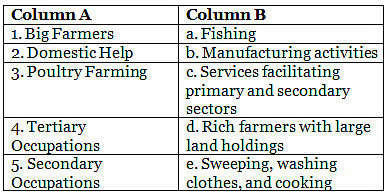Worksheet: Rural and Urban Livelihood | Footprints Class 6: Book Solutions, Notes & Worksheets PDF Download
Q1: Multiple Choice Questions (MCQs)
(i) What is the main focus of primary occupations?
(a) Manufacturing goods
(b) Extracting raw materials from the natural environment
(c) Providing services
(d) None of the above
(ii) Which of the following is a tertiary occupation?
(a) Agriculture
(b) Mining
(c) Banking
(d) Forestry
(iii) What percentage of the Indian workforce is engaged in agriculture, according to the India Economic Survey 2018?
(a) Less than 20%
(b) Around 30%
(c) More than 50%
(d) Approximately 70%
(iv) What do medium-level farmers primarily grow?
(a) Cash crops
(b) Wheat, barley, paddy, and pulses
(c) Fruits and vegetables
(d) Livestock
(v) Which sector does Savitha, who works in a bank, belong to?
(a) Primary
(b) Secondary
(c) Tertiary
(d) Quaternary
Q2: Fill in the Blanks
(i) ____________ are manufacturing activities that transform raw materials into finished goods.
(ii) ____________ is the world's single largest producer of milk since the mid-1990s.
(iii) In rural areas, ____________ is an important means of livelihood for families living near the seashore or rivers.
(iv) The White Revolution in India was initiated by the ____________.
(v) ____________ refers to the movement of people from rural to urban areas in search of better opportunities.
Q3: Match the Column (In a Table)

Q4: True/False
(i) Landless or marginal farmers often work on their own land.
(ii) The White Revolution aimed to make India self-sufficient in wheat production.
(iii) Migration refers to the movement of people from urban to rural areas.
(iv) Savitha, working in a bank, belongs to the unorganized sector of labor.
(v) The growth and development of India are dependent only on the progress of the urban sector.
You can access the solutions to this worksheet here.
|
65 videos|125 docs|25 tests
|
FAQs on Worksheet: Rural and Urban Livelihood - Footprints Class 6: Book Solutions, Notes & Worksheets
| 1. What are the main differences between rural and urban livelihoods? |  |
| 2. How do people in rural areas earn a living? |  |
| 3. What challenges do rural communities face compared to urban areas? |  |
| 4. How do urban livelihoods impact the environment? |  |
| 5. What skills are important for success in both rural and urban livelihoods? |  |
|
65 videos|125 docs|25 tests
|

|
Explore Courses for Class 6 exam
|

|
















